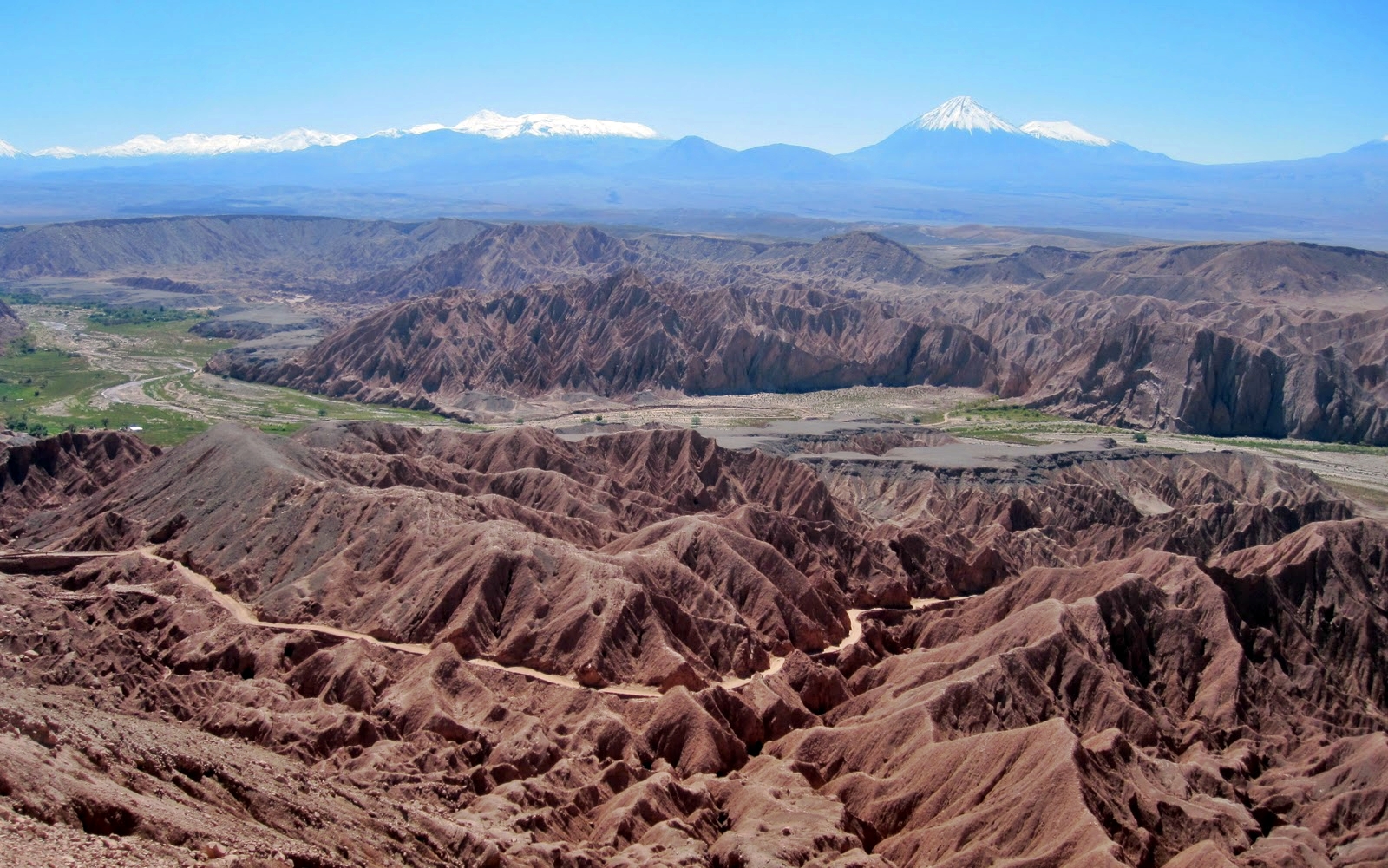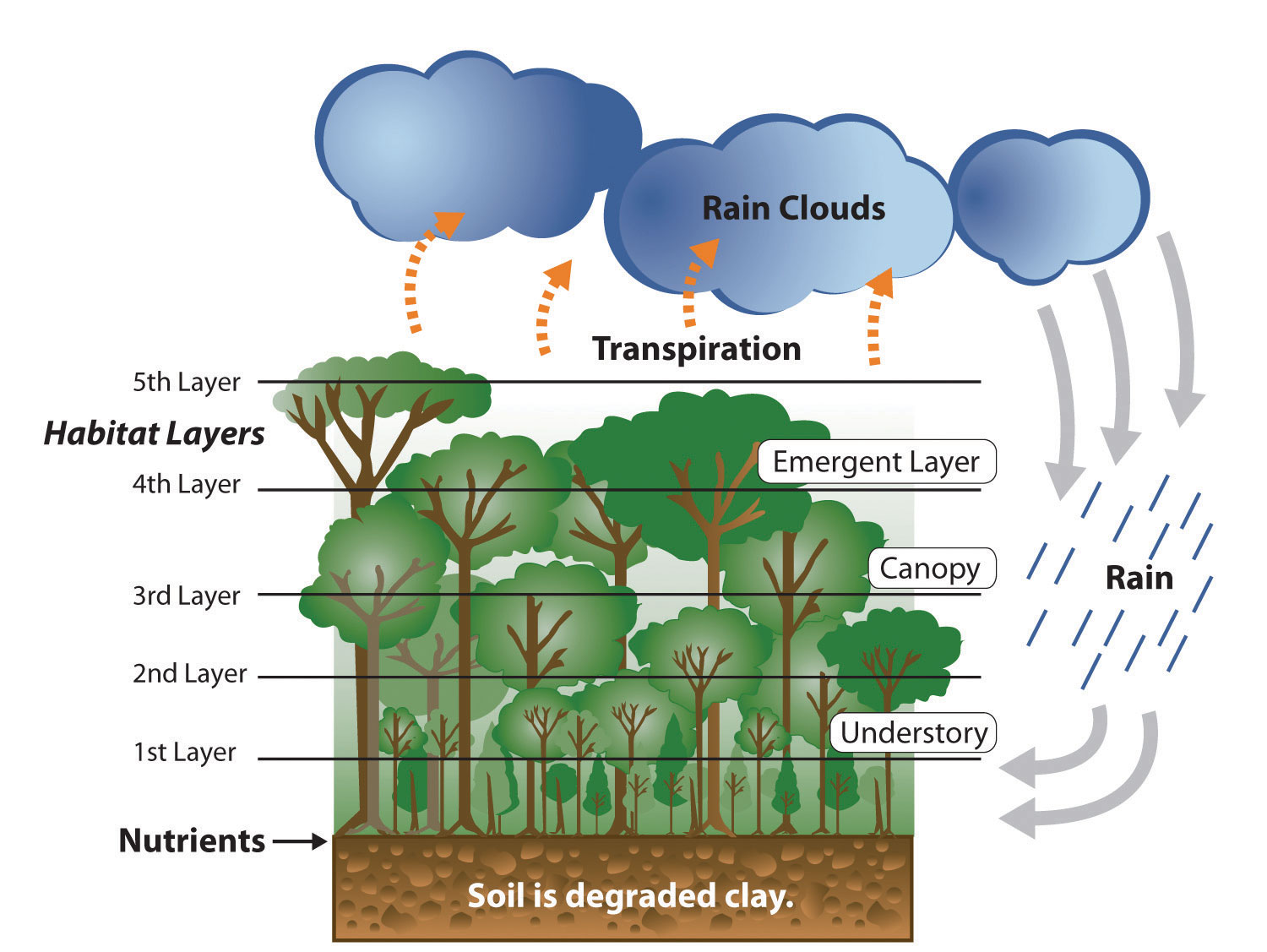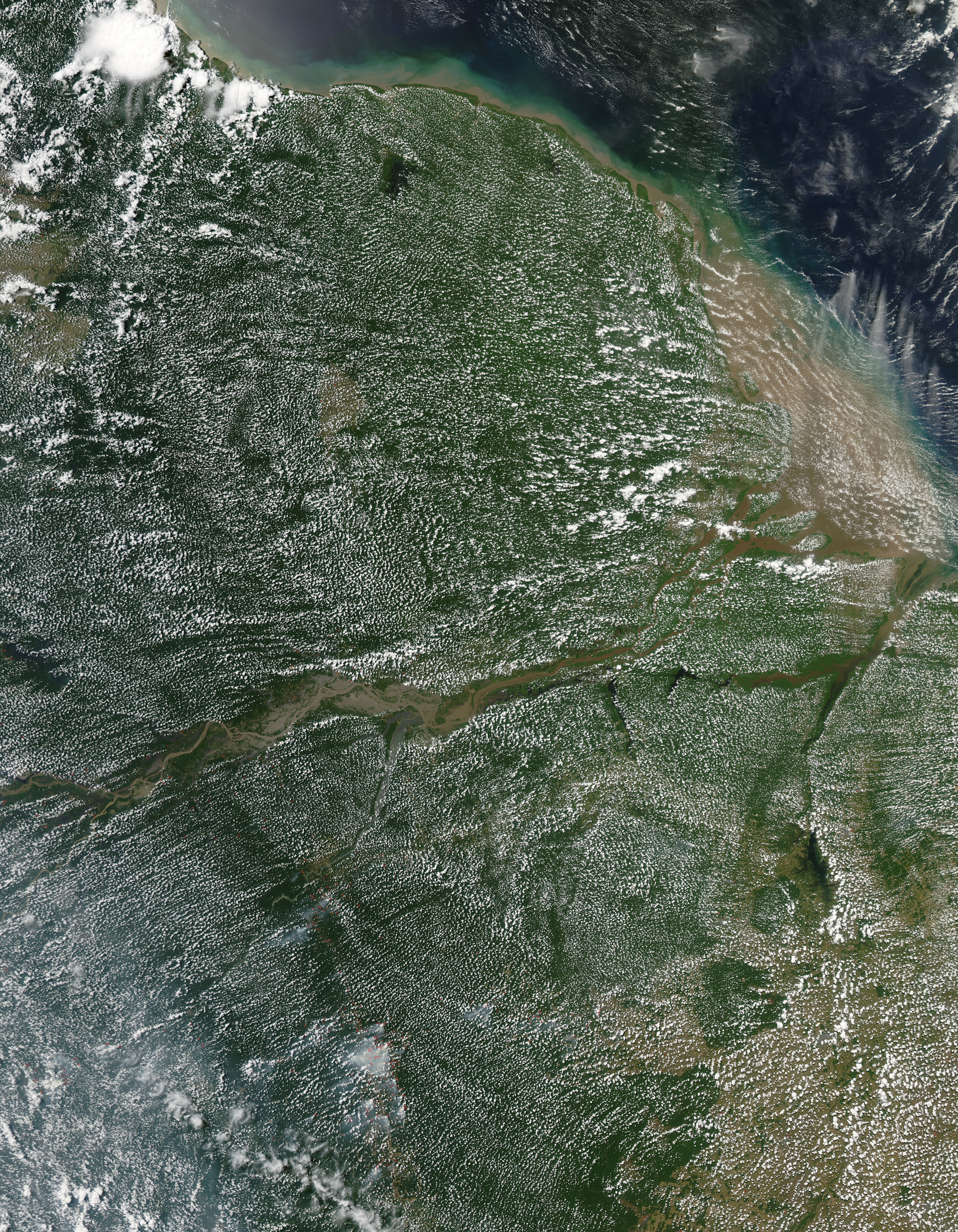The far-reaching Andes Mountains and the massive Amazon River system dominate South America’s physical geography. The five-thousand-mile-long Andes Mountain chain extends along the entire western region of the continent from Venezuela to southern Chile. The Andes is the longest mountain chain on Earth and the highest in the Americas. The Andes Mountain range has more than thirty peaks that reach at least twenty thousand feet in elevation, many of which are active volcanoes. The Andes has provided isolation to the Inca Empire, mineral wealth to those with the means for extraction, and a barrier to travelers crossing the continent. The Andes’ minerals include gold, silver, tin, and other precious metals. Mining became a significant industry in the colonial era and continues to the present.
At the core of the continent is the mighty Amazon River, which is more than two thousand miles long and has an enormous drainage basin in the largest tropical rain forest in the world. Amazon’s many tributaries are more extensive than many other world rivers. Flowing parallel to the equator, the Amazon is in contention with the Nile as the longest river in the world. In 2007, a dispute arose over the actual length of the Amazon River. Brazilian scientists using satellite imagery and teams on the ground using a global positioning system (GPS) calculated a new length for the Amazon. Using similar methods, the Nile River also had a new length calculated. Both were determined to be longer than initially measured. Currently, the actual length of each river is openly disputed. The most accurate statement is that the Amazon River has the highest discharge of any river in the world, and it is potentially also the longest river in the world.
 The Amazon carries about a fifth of all river water in the world. The Amazon and its many tributaries drain the entire interior region of the continent, covering 40 percent of South America. During the rainy season, the Amazon River can be more than one hundred miles wide. No bridges span the Amazon River. Its source is a glacial stream located high in the Peruvian Andes, about 150 miles from the Pacific Ocean.
The Amazon carries about a fifth of all river water in the world. The Amazon and its many tributaries drain the entire interior region of the continent, covering 40 percent of South America. During the rainy season, the Amazon River can be more than one hundred miles wide. No bridges span the Amazon River. Its source is a glacial stream located high in the Peruvian Andes, about 150 miles from the Pacific Ocean.
The Amazon’s extended tributaries, such as the Rio Negro, the Madeira, and the Xingu, move massive amounts of water through the Amazon Basin and are significant rivers. The Amazon has more than 1,100 tributaries; a dozen are more than one thousand miles long. Hydroelectric dams are located on the tributaries to produce electricity for the region’s fast-growing development. South America has additional large rivers that drain the continent, including the Orinoco, which flows through Venezuela, the Sao Francisco, which flows through southeast Brazil, and Paraguay and the Paraná Rivers, which flow south from Brazil into the Rio de la Plata between Argentina and Uruguay.
Lake Titicaca rests in the middle of the Altiplano Region of the Central Andes on the border between Peru and Bolivia. The Altiplano region is a broad basin between two main Andean mountain ranges. The word altiplano means “valley” in Spanish. There is a substantial number of altiplanos in South America. They provide for agricultural production and human habitation. The Altiplano region has been home to ancient civilizations that date back to early human settlements. Lake Titicaca is a large freshwater lake about 120 miles long and 50 miles wide. The surface is at an elevation of about twelve thousand feet above sea level, and the lake is more than nine hundred feet deep in some areas. Usually, at such high elevations, the temperature would dip below freezing and restrict agriculture. However, the large lake acts as a solar energy collector by absorbing energy from the sun during the day and giving off that energy in the form of heat during the night. The energy redistribution allows for a moderate temperature around the lake that is conducive to growing food crops. With abundant freshwater and the ability to grow food and catch fish, the Altiplano Region has supported human habitation for thousands of years. On the Bolivian side of the lake is the ancient stone site of Tiahuanaco, which has had some artifacts dated to 1500 BCE or earlier. People continue to live around and on Lake Titicaca and maintain a subsistence lifestyle.
Across the Andes Mountains from the Altiplano Region is the Atacama Desert. The Atacama is one of the driest places on Earth: in some parts, no rain has fallen in recorded history. In normal circumstances, the Atacama would be a desolate region without human activity, but that is not the case. Some of the world’s largest copper reserves are found here. Nitrates, which are used in fertilizers, are also found in large quantities. Mining the Atacama has brought enormous wealth to people fortunate enough to be on the receiving end of the profits. The rain shadow effect is responsible for the extraordinary dryness of the Atacama. The Andes are quite high at this latitude, and the winds blow in rain clouds from the east. When the clouds reach the mountains, they ascend in elevation, releasing their precipitation without ever reaching the western side of the Andes.
 South America has vast agricultural plateaus east of the Andes, such as the Mato Grosso Plateau, which includes a portion of the great cerrado agricultural region of central Brazil. The Cerrado is a vast plain that has been developed for agriculture and produces enormous harvests of soybeans and grain crops. Bordering the Cerrado to the southeast are the Brazilian Highlands, an extensive coffee-growing region. The Pampas in eastern Argentina, Uruguay, and southernmost Brazil is another agricultural region with good soil and adequate rainfall. Farming, cattle ranching, and even vineyards can be found here, making the Pampas the breadbasket of the Southern Cone. To the south of the Pampas is the lengthy expanse of Patagonia, which covers the southern portion of Argentina east of the Andes. Patagonia is a prairie grassland region that does not receive very much rainfall because of the rain shadow effect of the Andes to the west. The main activities in Patagonia are the raising of cattle and other livestock. The region is starting to attract attention to the extraction of natural resources such as oil, natural gas, and valuable minerals.
South America has vast agricultural plateaus east of the Andes, such as the Mato Grosso Plateau, which includes a portion of the great cerrado agricultural region of central Brazil. The Cerrado is a vast plain that has been developed for agriculture and produces enormous harvests of soybeans and grain crops. Bordering the Cerrado to the southeast are the Brazilian Highlands, an extensive coffee-growing region. The Pampas in eastern Argentina, Uruguay, and southernmost Brazil is another agricultural region with good soil and adequate rainfall. Farming, cattle ranching, and even vineyards can be found here, making the Pampas the breadbasket of the Southern Cone. To the south of the Pampas is the lengthy expanse of Patagonia, which covers the southern portion of Argentina east of the Andes. Patagonia is a prairie grassland region that does not receive very much rainfall because of the rain shadow effect of the Andes to the west. The main activities in Patagonia are the raising of cattle and other livestock. The region is starting to attract attention to the extraction of natural resources such as oil, natural gas, and valuable minerals.
To the northern part of the continent in Venezuela and Colombia, sandwiched between the Andes Mountains and the Guiana Highlands, is a grassland region with scrub forests called the Llanos. The human population is small because of the remoteness of the region along the Orinoco River basin. The Guiana Highlands of southeast Venezuela and the Guianas are an isolated set of mountainous plateaus mixed with rugged landscapes and tropical climates. Angel Falls, the highest waterfall in the world, with a free fall of more than 2,647 feet and a total drop of about 3,212 feet (more than half a mile), is located here. To the northwest of the Llanos and the Guiana Highlands in Venezuela is Lake Maracaibo, a large inland lake open to the Caribbean Sea. A coastal lake, Maracaibo rests atop vast oil reserves that provide economic wealth for Venezuela.
El Nino and La Nina
Short-term changes in climate are common, with the largest and most important of these is the oscillation between El Niño and La Niña conditions. This cycle is called the El Niño Southern Oscillation (ENSO). The ENSO drives changes in climate that are felt around the world about every two to seven years.
In a typical year, the trade winds blow across the Pacific Ocean near the equator from east to west (toward Asia). A low-pressure cell rises above the western equatorial Pacific. Warm water in the western Pacific Ocean and raises sea levels by a one-half meter. Along the western coast of South America, the Peru Current carries cold water northward, and then westward along the equator with the trade winds. Upwelling brings cold, nutrient-rich waters from the deep sea.
In an El Niño year, when the water temperature reaches around 28 degrees C (82 degrees F), the trade winds weaken or reverse direction and blow east (toward South America). Warm water is dragged back across the Pacific Ocean and piles up off the west coast of South America. With warm, low-density water at the surface, upwelling stops. Without upwelling, nutrients are scarce, and plankton populations decline. Since plankton forms the base of the food web, fish cannot find food, and fish numbers decrease as well. All the animals that eat fish, including birds and humans, are affected by the decline in fish.
By altering atmospheric and oceanic circulation, El Niño events change global weather patterns. Some regions receive more than average rainfall, including the west coast of North and South America, the southern United States, and Western Europe. Drought occurs in other parts of South America, the western Pacific, southern and northern Africa, and southern Europe.
An El Niño cycle lasts only a few years, with normal circulation patterns resuming. Sometimes circulation patterns bounce back quickly and remarkably, called La Niña. During a La Niña year, as in a typical year, trade winds move from east to west and warm water piles up in the western Pacific Ocean. Ocean temperatures along coastal South America are colder than average (instead of warmer, as in El Niño). Coldwater reaches farther into the western Pacific than usual.
Other significant oscillations are smaller and have a local, rather than global, effect. The North Atlantic Oscillation mostly alters the climate in Europe. The Mediterranean also goes through cycles, varying between being dry at some times, and warm and wet at others. For more information on El Nino and La Nina, check out the National Oceanic and Atmospheric Administration (NOAA).
Amazon Rainforest and Destruction
The Amazon rainforest is considered one of the largest, roughly 2 million square miles, and biologically diverse rainforests in the world. The vast majority of the rainforest exists within Brazil (60 percent), followed by Peru (13 percent), Columbia (10 percent) and a few other South American countries.
Wet tropical rainforests like the Amazon have some of the richest biomes and biodiversity on the planet. Ecologists believe that 1 in 10 plant and animal species live in the Amazon rainforest, making it the largest habitat of species. Scientists have scientifically classified the following regarding the biodiversity of the Amazon:
- 2.5 million insect species
- 40,000 of plant species
- 2,200 fish species
- 1,294 bird species
- 427 mammal species
- 428 amphibian species
- 378 reptile species
Deforestation, the conversion of forested habitats to non-forested habitats, has reduced the habitat critical to the survival of native species. An estimated 50 percent of the earth’s species live in tropical rain forests, which only cover about 5 percent of the earth’s surface. Tropical rain forests in the Amazon Basin are being cut down at an unsustainable rate, creating severe environmental problems. Loggers cut down the large trees, and the rest are usually burned to allow the ash to provide nutrients for other plants. The cleared areas are most often used by cattle ranchers until the soil is no longer viable. Then more forest is cut down, and the process continues. Speculation that land prices will increase as the region becomes more developed encourages this process.
During the 1960s, there was limited access to the interior of the Amazon basin. Any farming that was done within the rainforest was slash-and-burn agriculture. Even though the rainforest has plenty of moisture, the soil is deficient in nutrients because the excess precipitation washes away the nutrients. Slash-and-burn agriculture is a process where local farmers will cut down (slash) and burn the trees to replenish nutrients back into the infertile soil. This allows farmers to grow crops for a few years, until the precipitation leaches out all of the nutrients. Since many farmers in the Amazon live in poverty, they do not have access to fertilizer. So after the soil becomes nutrient deficient again, local farmers most move on to new areas within the rainforest and start the slash-and-burn process again.
The forest has many layers of habitat. Soils in the tropics are deficient in nutrients, which have been leached out by the abundant rainfall. The nutrients are on the surface layer of the ground built up from falling leaves, branches, and debris decomposing on the forest floor. The removal of the forests removes these nutrients and results in severe soil erosion. Tropical forests usually expand along the edges where falling debris from the trees collects and provides nutrients for young plants.
There is much discussion among environmentalists, scientists, and other concerned people about deforestation in the Amazon region, usually with a focus on the devastation that results from the loss of forested areas. Forest studies have indicated that tropical rain forests are quite resilient and can recover with proper forest management. However, clear-cutting large, extensive areas for timber leaves an area devastated for an extended period. Clear-cutting could be replaced by strip cutting, which would harvest trees in narrower strips, leaving rows of trees standing. Strip cutting allows for more edges to be available for young plants to get their start to replenish the forest.

The image above illustrates that the nutrients of the tropical rain forest ecosystem rest on the forest floor because tropical soils are degraded. The forest canopy has many habitat layers providing homes to a diversity of organisms. Dense tropical rain forests also contribute to the process of transpiration, which cycles precipitation from the ground back into the atmosphere where it can collect and return in the form of rain.
Additional forest habitat is lost when rivers are dammed up for hydroelectric power, and thousands of acres of tropical rain forests are flooded. Decomposing plant material in the reservoirs behind the dams increases the water’s acidity, causing erosion to the hydroelectric turbines. The turbines have a short life span, so the dams are a short-term energy solution that creates long-term problems. The large flooded areas reduce the habitat for tropical organisms and restrict the use of the land for other purposes. Flooding can extend into traditional hunting grounds for indigenous groups, who have little political power to restrict this type of development.
Today, roughly 70-80 percent of the deforestation within the Amazon rainforest is for creating pastures for livestock, specifically cows. The remaining 20-30 percent of the areas being deforested has been for growing soybeans or sugarcane, and drilling for oil.
Amazon Rainforest Fires of 2019

In 2019, the world was reminded of deforestation in the Amazon rainforest. It is believed that there were over 72,843 wildfires in Brazil alone, which was an 88 percent increase from 2018. It is not fully known how or why there were so many fires in 2019, but the likely culprits were either arsonists, industry, and climate change.

The Amazon rainforest is considered a “carbon sink,” meaning that it absorbs fast quantities of carbon dioxide out of the atmosphere. The rainforest also interacts with the vast moisture in the atmosphere and can create clouds that aid in creating precipitation back to the forest, creating a micro-water cycle. However, scientific research has indicated that deforestation may cause the rainforest to dry out, which could alter climates around the world. As the Amazon rainforest is burned down, it could hinder the local clouds created by the forest, thus dying out of the region.
